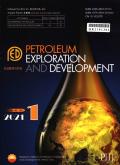Tectonic deformation and its petroleum geological significance of continental margin necking zone in deepwater area of Pearl River Mouth Basin, South China Sea
IF 8
Q1 ENERGY & FUELS
引用次数: 0
Abstract
Based on a set of high-resolution 3D seismic data from the northern continental margin of the South China Sea, the lithospheric structure, thinning mechanisms and related syn-rift tectonic deformation response processes in the crustal necking zone in the deepwater area of the Pearl River Mouth Basin were systematically analyzed, and the petroleum geological significance was discussed. The necking zone investigated in the study is located in the Baiyun Sag and Kaiping Sag in the deepwater area of the Pearl River Mouth Basin. These areas show extreme crustal thinned geometries of central thinning and flank thickening, characterized by multi-level and multi-dipping detachment fault systems. The necking zone exhibits pronounced lateral heterogeneity in structural architectures, which can be classified into four types of thinned crustal architectures, i.e. the wedge-shaped extremely thinned crustal architecture in the Baiyun Main Sub-sag, dumbbell-shaped moderately thinned crustal architecture in the Baiyun West Sub-sag, box-shaped weakly thinned crustal architecture in eastern Baiyun Sag, and metamorphic core complex weakly thinned crustal architecture in the Kaiping Sag. This shows great variations in the degree and style of crustal thinning, types of detachment faults, distribution of syn-rift sedimentary sequences, and intensity of magmatism. The thinning of the necking zone is controlled by the heterogeneous rheological stratification of lithosphere, intensity of mantle-derived magmatism, and deformation modes of detachment faults. The syn-rift tectonic deformation of the necking zone evolved through three phases, i.e. uniform stretching during the early Wenchang Formation deposition period, necking during the late Wenchang Formation deposition period, and hyperextension during the Enping Formation deposition period. The crustal thinning extent and architectural differentiation in these phases were primarily controlled by three distinct mechanisms, i.e. the pure shear deformation activation of pre-existing thrust faults, the simple shear deformation of crust-mantle and inter-crust detachment faults, and differential coupling of lower crustal flow and ductile domes with main detachment faults. The hydrocarbon accumulation and enrichment in the necking zone exhibit marked spatial heterogeneity. Four distinct crustal thinned architecture-hydrocarbon accumulation models were identified in this study. The hydrocarbon accumulations in the shallow part exhibit significant correlations with their deep crustal thinned architectures. The unique lithospheric structure and deformation process predominantly control the favorable hydrocarbon accumulation zones with excellent source-fault-ridge-sand configurations, which is critical to reservoir-forming. The most promising exploration targets are mainly identified on the uplift zones and their seaward-dipping flanks associated with the middle and lower crustal domes. This research provides additional insights into lithospheric thinning-breakup process at intermediate continental margins of marine sedimentary basins, being significant for guiding the deepwater petroleum exploration in the Pearl River Mouth Basin.
南海珠江口盆地深水陆缘颈缩带构造变形及其油气地质意义
基于南海北部大陆边缘高分辨率三维地震资料,系统分析了珠江口盆地深水区地壳颈缩带岩石圈结构、减薄机制及相关同裂谷构造变形响应过程,并探讨了其油气地质意义。研究的颈状带位于珠江口盆地深水区白云凹陷和开平凹陷。这些地区呈现出中央减薄、侧面增厚的极端地壳减薄几何形状,具有多层次、多倾斜滑脱断裂体系的特征。颈颈带构造构造横向非均质性明显,可将其划分为4种薄壳构造类型,即白云主凹陷楔状极薄壳构造、白云西凹陷哑铃状中薄壳构造、白云凹陷东部箱状弱薄壳构造和开平凹陷变质核杂岩体弱薄壳构造。这表明在地壳减薄程度和样式、拆离断裂类型、同裂谷沉积层序分布和岩浆活动强度等方面存在很大差异。颈化带的减薄受岩石圈非均质流变分层、幔源岩浆活动强度和滑脱断裂变形模式的控制。颈化带的同裂谷构造变形经历了文昌组早期的均匀伸展、文昌组晚期的颈化和恩平组沉积期的超伸展三个阶段。这些阶段的地壳减薄程度和构造分异主要受三种不同机制的控制,即既有逆冲断层的纯剪切变形激活、壳幔和壳间拆离断层的单纯剪切变形、下地壳流动和韧性丘与主拆离断层的差异耦合。颈缩带油气成藏富集表现出明显的空间异质性。本研究确定了四种不同的地壳薄化构造-油气成藏模式。浅部油气聚集与深部地壳薄化结构具有显著的相关性。独特的岩石圈构造和变形过程主导着具有良好源-断-脊-砂配置的油气成藏有利带,对成藏至关重要。最有希望的勘探目标主要在与中、下地壳穹窿相关的隆起带及其向海倾斜的侧翼。该研究为海相沉积盆地中陆缘岩石圈减薄-破碎过程提供了新的认识,对指导珠江口盆地深水油气勘探具有重要意义。
本文章由计算机程序翻译,如有差异,请以英文原文为准。
求助全文
约1分钟内获得全文
求助全文

 求助内容:
求助内容: 应助结果提醒方式:
应助结果提醒方式:


